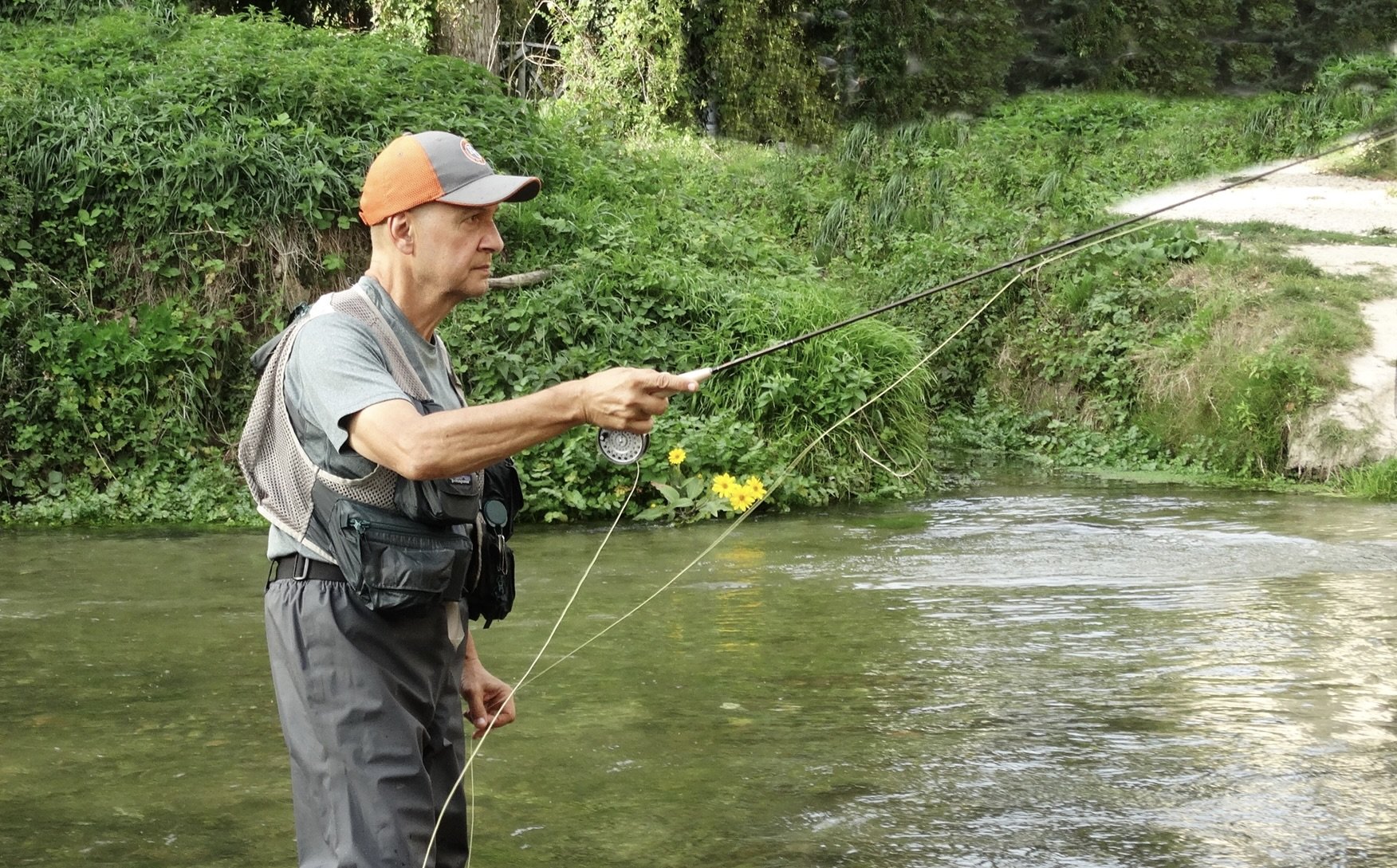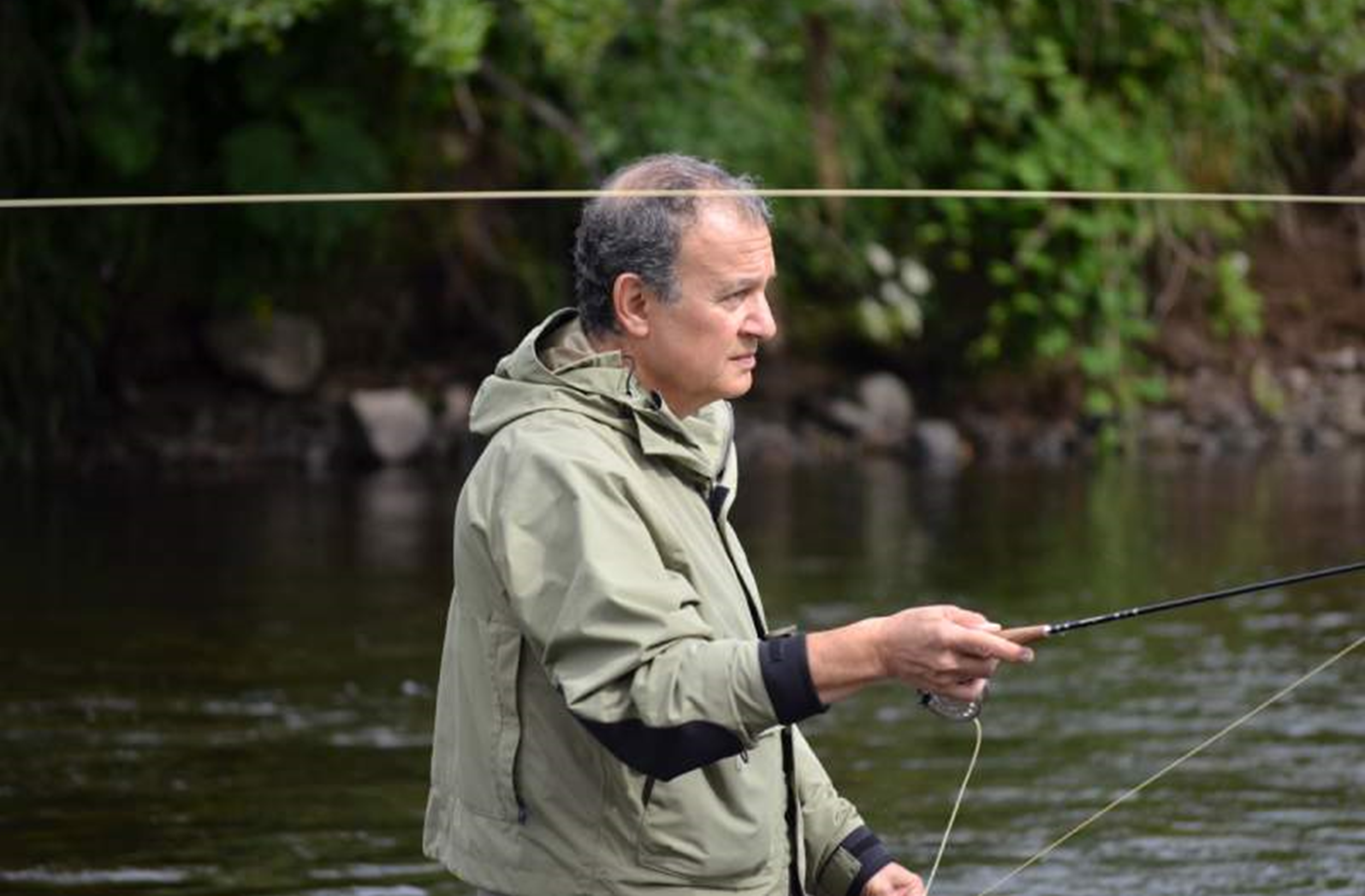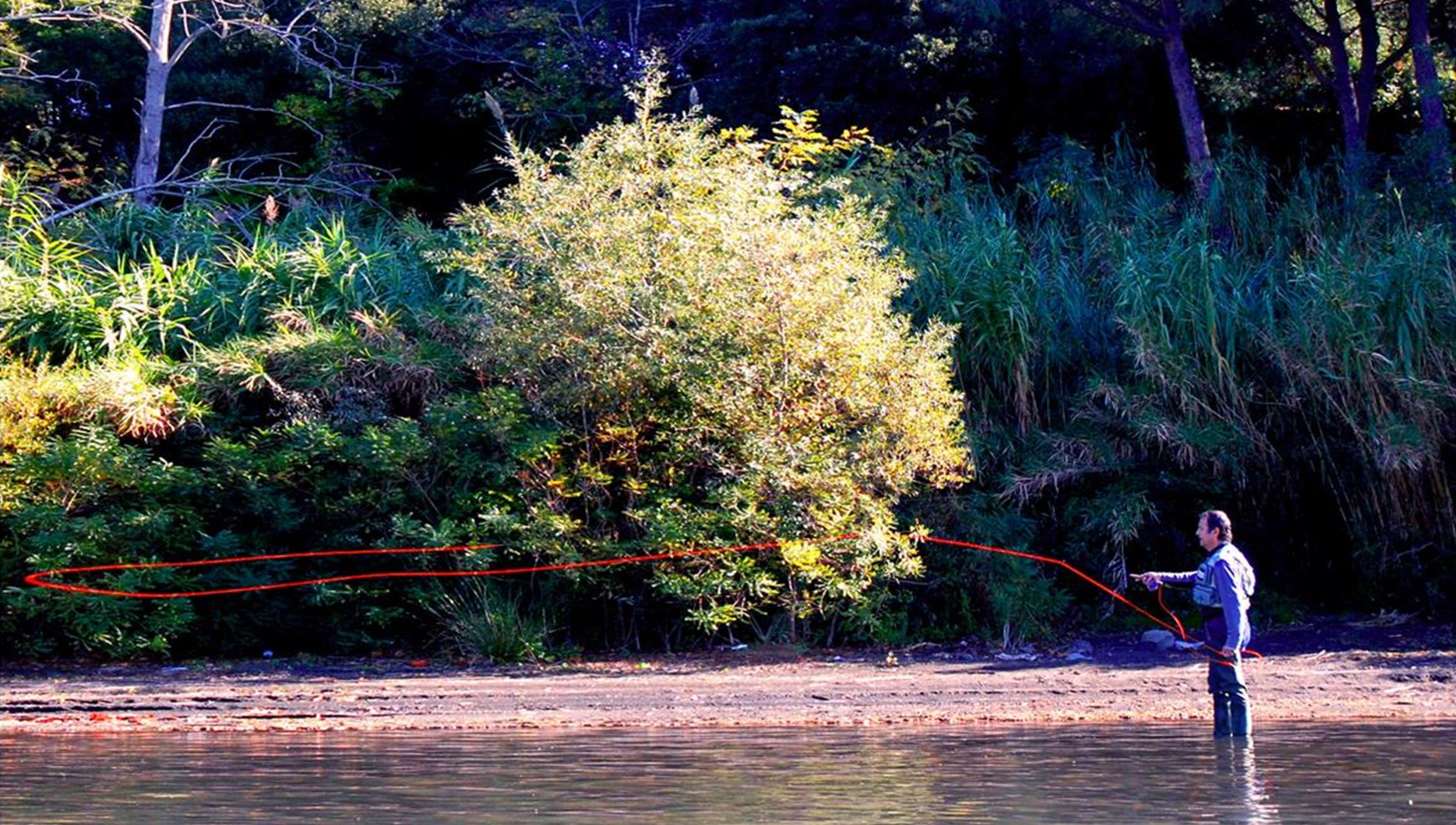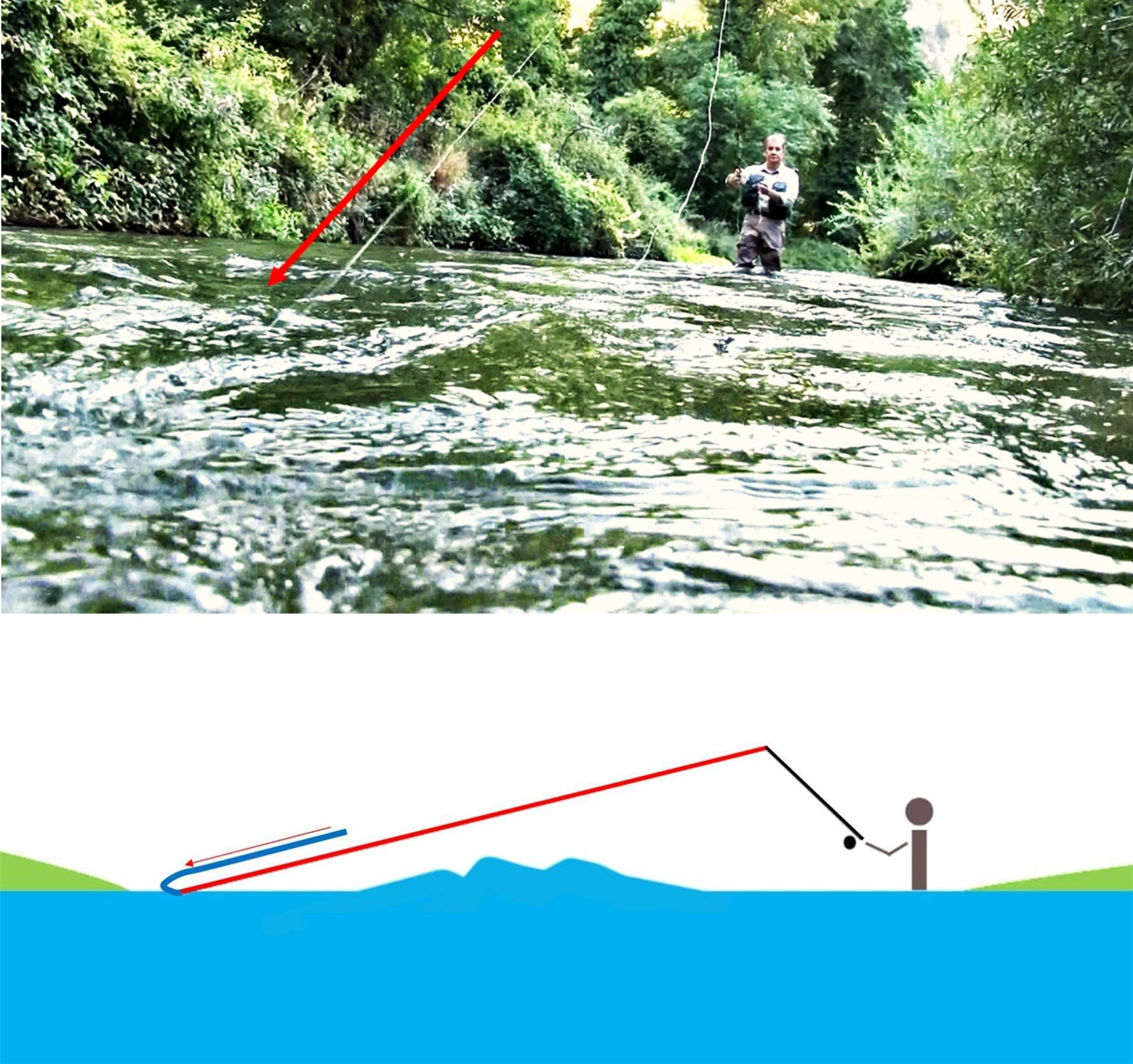
Massimo Magliocco
1. Choice of equipment Rods, reels, fly lines, fly floatants, clothes, glasses and other useful items.
I am so in love with dry fly fishing that I wrote a book called "Dry fly fishing in fast water" because 95% of dry fly fishing takes place in fast water, only a small percentage takes place in calm water. I am not talking about chalck streams where fishing is related to insect hatching, but most trout rivers have fast waters so it is unthinkable that dry fishing can only be practiced in the few and very small pools of slow water that we find in the rivers in addition only if there is some trout that rises. So in Italy, we have developed a casting and fishing technique designed precisely for these waters.
Rod
Back to us, my rod is a 7 '6'' and it must have a real progressive action. I have been saying this as a fly rod designer for over twenty years now, and there are many famous rods that are advertised as progressive action rods but often this is not the case. However, a rod suitable for dry fly fishing, for our technique, the Italian one, must have a butt that must not be too stiff or too soft, i.e. it must flex with a minimum of difficulty. Discard all ones that do not fit into this series. The tip of the rod must be sensitive but not too soft, in other words, it must be the natural continuation of the sections below.
Reel
The reel must be small enough to hold the line and very light. So no clutches and other things that are useless.
Line
The line I use is a DT3F because in my opinion it is the best both for laying in water and for its management in relation to the corrections of the cast.
Fly floatants
I do not consider it an important element, if you have a good, well-built fly and you use two precise casts to lift the fly off the water, it will hardly get wet and a couple of false casts will be enough to dry it. The two casts are the Wave and the Spiral that lift the fly off the water without making a noise and without letting it get wet.
Clothes
The same thing applies to clothes too. I use a comfortable jacket, and a pair of waders without going behind the fashion. Today, many fishermen give more importance to technical clothing, which is still needed, than to fishing equipment.
Glasses
A good pair of polarized glasses can be useful, even if I hardly ever wear them, because fishing only dry flies maybe they are not needed.
2. Leader material, build up, length and knots
In my opinion the leader is the most important part of the fly fishing tackle, it's so important that I wrote a book about the leader last year, "Tra la coda e la mosca -Between the line and the fly" we are translating it into english https://www.amazon.co.uk/coda-mosca-Italian-Massimo-Magliocco-ebook/dp/B08L9NW3BV/ref=sr_1_1?keywords=tra+la+coda+e+la+mosca&qid=1638547036&sr=8-1
Because in addition to the cast, it is through the leader that you can fight dredging, so it must have characteristics that make it balanced.
First of all, it must be long at least 5 meters. It can be odd for the ones that fish only in stream, but 5 meters long can be managed without any problem, but you need to have a right leader. In fast water it is impossible to use a leader shorter than 5 meters otherwise the dredging is immediate. The percentages that I have defined over the years of testing are 36% for the butt, 36% for the taper, 28% for the tippet each of its total length. These percentages are very different to the ones still widely used which are 60% - 20% - 20% which make the leader much faster. As my teacher Roberto Pragliola creator of the Italian style (TLT) of which I was an exponent said, the leader must not be stretched out because it causes immediate dredging. As Roberto said, the right leader is the one who can be stretch out with a little difficulty. My leader measurements are:
180cm 0,50
90cm 0,40
60cm 0,30
30cm 0,20
140cm 0,14/0,12
Total 5 meters
The knots must not exceed the number of 4 otherwise the leader becomes too rigid and difficult to manage. Think about making a simple curved cast, casting with a 270cm long leader and with 5-6-7-etc knots, how can you manage it? Another important thing is that the mono pieces must be decreasing by 10 not by 5. I invented the “looped leader” that instead of being joined by knots, it is joined by two micro loops for each stretch of mono. This allows the leader to adapt very well to surface currents. Take a look here: http://www.massimomagliocco.co.uk/uncategorized/the-leader.html
I always say that "you can have a great rod and a great line but if you have a poor leader, your equipment will be very difficult to manage".
3. Approach and stealth.
The first thing to say is that the character of the trout is not the same, this depends on where they live. A trout that lives in a chalck stream it will be completely different from the trout that lives in a stream. In fact, the one of chalck stream will be less afraid than the other one that lives in a stream, therefore, the approaches of the two types of rivers are different. Once whilst I was preparing to cast to a trout that was rising during a hatch, a horse appeared from behind a bush and calmly sauntered down to the river to drink right in the spot where the trout was. The fish moved away a few metres and once the horse had gone calmly returned to feed on the hatching insects. However, this does not happen when a man appear, then the trout’s response is to escape and hide itself, after which it takes a considerable time to recover. Thus the trout sees man as something to be fearful of, an unknown animal that is a potential danger. The angler’s approach and subsequent attack are like a game of chess in which every step must be meticulously planned in advance. After all, the trout is there and rushing will not make its capture any easier. Calmness and a studied approach and subsequent cast in this phase are the winning cards.
Anyway, get to the point where to cast and up to this point we have taken everything into consideration: we have chosen the best approach route, we are facing the sun; we have tiptoed so as not to make noise; hence we have planned our approach brilliantly, but now no one can help us to cast. The biggest problem comes after you have successfully entered the trout’s cone of vision without being detected, then you pass into the second phase, the cast. The fast water trout gives you no second chances and if years of experience have led us to the best point to cast from without being seen by the trout, as soon as we need to cast if we improvise will meet certain defeat. In other words, everything we did well in approaching the trout will be ruined by our bad cast. So I ask again, which is more important, the fly or the cast? Take a look here: https://www.anglebooks.com/catalogsearch/result/?q=magliocco
4. Reading the water
This is one of the cornerstones of dry fly fishing especially in fast water. While in chalck streams reading is much easier as you often see the fish and you have to wait for them to start to rise to be able to catch them with dry fly, in fast waters we have to understand where the fish maight be, and this often can be a problem, but once you achieve this goal, then you have to make it interested to your fly and here's the big problem to overcome. In my opinion, however, it is not enough just to know how to read water that anyway is essential, but immediately afterwards you have to put into practice what I call the "five rules of the river" which are:
1) Short casts.
2) Knowledge of the currents.
3) Knowledge of the role of rocks.
4) The food (routes in hatches and in hunting).
5) The approach.
These five rules must always be used together and not individually.
5. Casting ability which casts are essential.
I have been teaching casting for more than 30 years, so I can say that there are three types of casts, the utility ones, the fast ones and the anti-dredging ones. The surface of moving waters is never the same as another one so this means that your approach and the types of casts you will use to fight drag will require different solutions. That is there isn’t only one way to fight drag but various solutions for different situations. When fishing dry fly, the anti-dredging ones are absolutely the most important such as the Slowed down angular cast and the Overturned Cast. With these two casts you can cover 100% of all current situations you find in a river. The Slowed down angular cast is executed when between the fisherman and his goal there is a very fast current. The operation is very simple and consists in slowing down the casting movement operating with the rod held very high and with a very short arch. Once you have taken your aim and tighten your loop as much as possible to concentrate everything in a small space, you let the line go down to the water by inertia so that part of the line and the whole leader pile up. Also in this case you need to release your left hand very early. At the end your line and leader will pile up in the faster current and this will delay the drag considerably.
We use the Overturned Cast when between the fisherman and his goal there is a slower current than on the opposite bank. In other words the scope of this cast is to create a good curve to contrast the strong opposite current. But beware – the overturned casts do generate a curve but are not part of those casts that are properly defined as Curved Casts and which are executed in a different way. The difference beetween a simple curved cast and the Overturned Cast is that with the firts one the curve occurs in the air so it will almost never be accurate. Instead the overturned cast first puts the fly where you saw the trout or where you think it is and then make the curve. This absolutely changes its effectiveness.
You cast like you would normally do towards your goal having taken care of preparing two wide loops of line in your left hand. When the fly is about to touch the water you cast out the first loop and at the same time you bring your rod down and parallel to the surface with the reel seat near your leg. Without stopping, and this is of fundamental importance so that the line will come into contact with the water as late as possible, you lift the rod with a wide rotation until it is vertical to cast the line again so that it “opens against the current”.
As mentioned I use the Wave and the Spiral casts which are useful to lift the fly off the water without creating waves, splashes and getting your fly completely soaked.
Last but not least, there are the so-called fast casts which are used to land the fly under the bushes without dredging it. They are the Superimposed cast and Under tip cast. However, they are a bit challenging and the angler must be experienced enough in casting to be able to execute them. There is no need to have a very tight loop if we just do "up and down" with the rod. Often the fisherman who only knows how to do the tight loop, thinks he is a good fisherman but this is useless if he does not know the other dynamics of the other casts that allow him to fish.
6. Entomology, what should we know
Regarding entomology, I believe that we should only know the essential, even if I know fishermen who, over time, have become real experts in this field. In my opinion, the problem is that if you base fly fishing almost exclusively on the knowledge of insects, you risk neglecting the real elements that then allow you to fish better, such as casting, which in my opinion is the first element to study, but these are personal choices.
7. Rise forms Can they tell us something?
Good question. In my opinion it would take 10 pages to explain all kinds of how trout rise. I could say that there are several situations and we can divide them into:
Immediately below the surface
1) Trout's tail coming out
2) Trout rises making noise
3) Trout rises making big size circles
4) Trout makes hump-shaped like a dolphin
Above the surface
1) Trout makes a slight ripple
2) Trout rises and splashes in surface
3) Trout jumps off the water
4) Trout refusals
These are the main situations in which the trout rises to the surface.
It is very important to be able to recognize the type of trout rise especially for choosing the right fly. We must remember though, that these types of rises are almost only for calm waters because those in fast waters are often different.
8. Fly selection, size, shape, materials, which flies are essential, favourite fly.
Another good question. I can say that I have not been tying flies for at least 30 years, because I am not inclined to work on "small spaces", but I have my favorite ones. A fly that must never be missing in fishermen's fly boxes is the sedge because it covers both the exact insect and a generic fly for blind fishing. Another one for fast waters is the Royal Wulff as well as the 699 of Devaux and the A4. For hatching flies the iris, which is an Italian fly designed by one of the most important Italian fly tyers, Piero Lumini that I find extremely valid. Then the emergers and spent ones must never be missing. I would like to always have in my fly boxes the flies tied by my friend Angelo Rosorani who presented in his article here in this website. I still have some of them that he gave me but I don't fish with them for fear of losing them.
However in general, the fly for blind fishing must be, in my opinion, the smallest one that can float in fast waters.
However, I always say that: "We have to remember that you can have the best fly, tied with the most performing materials but, if you don't land it in the right place and in the best way, it serves no purpose". If you agree with my saying, you immediately understand how important the cast is.
9. Presentation and drifts
Fly presentation is of enormous importance especially when fishing in flat waters. If you use a terrestrial for example, you have to make it move slightly by simulating that it is striving to achieve the river bank. Or when you see couple of trout that will compete for the food, you have to land the fly that drifts between them, this will trigger the so-called food competition and they will launch themselves toward the fly trying to eat it immediately.
10. Upstream or downstream?
The trout needs oxygen and food therefore absolutely upstream, unless you find situations in which a reel of water causes the trout to be facing downstream.
11. fighting fish.
When a big fish is hooked and it remains locked on the bed of river, we should move the rod from right to left several times. This will irritate and confused the fish, causing it to move.
Another way of moving a fish ‘locked’ on the bottom the river is to put the line under tension with the rod tip held high followed by small, sharp knocks on the rod butt. These will be transmitted to the hook and will hopefully scare the fish that probably will start moving
Another way is we can fix a bit of metal chain on a split ring to the line and let it descend down the line, under tension, till it bumps into the fish’s head causing it to bolt off in fear.













